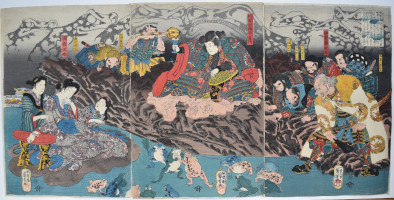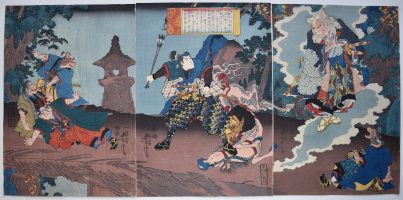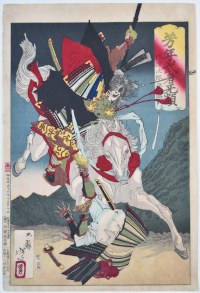/category/highlights/
Utagawa KUNIYOSHI (1797-1861)

Click here to view image full size.
A triptych showing Shoguntaro Taira Yoshikado (centre), his sister Takiyasha-hime (left), and Yoshikado’s retainer, Iga Jutaro, watching magic toads wrestling. Huge toads loom above them. Shogun Taro Yoshikado mikata wo atsumen ga tame etc. Takiyasha-hime was known for her toad magic which she had gained from a scroll containing their secrets given to her by her brother. Published by Tsuru-ya Kiyemon, 1842-3. Robinson T.89.
Fine impression, colour and condition. Signed Ichiyusai and Chooro Kuniyoshi ga.
Status: Available
Utagawa YOSHITORA (1836-1887)

Click here to view image full size.
A triptych showing the warrior Inukai Genpachi (the famous character from the Hakkenden) confronting a cat monster which has emanated from a horse on Mount Koshin. Other cat monsters stare in amazement. Published by Kojimaya Jubei, 1850.
Very fine impression. Fine colour. Imperceptible small binding holes, otherwise fine condition. Signed Ichimosai Yoshitora ga.
Status: Available
Tsukioka YOSHITOSHI (1839-1892)

Click here to view image full size.
Shows Sagami Jiro Taira no Masakado on horseback attacking an opponent and having cut his sword in two. From a set Yoshitoshi musha burui, “Yoshitoshi’s Courageous Warriors.” Published by Kobayashi Tetsujiro, 1883.
Very fine impression: This is the first edition with three-colour cartouche and small red seals in left margin. There are late editions of this set. It was republished by Tsunajima Kamekichi in 1886. Fine colour. Slight soil bottom edge, otherwise very good condition. Signed Taiso Yoshitoshi ga.
Status: Available